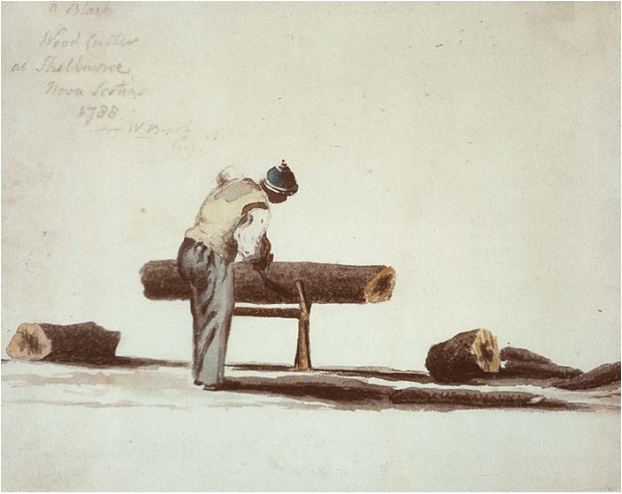
The two main Loyalist settlements in Canada were in the Saint John River valley in what is now New Brunswick, and temporarily in Shelburne, Nova Scotia. The Loyalists swamped the existing population of the Maritimes. In 1784, the colonies of New Brunswick and Cape Breton were created to deal with the influx.
Loyalists were as socially and culturally diverse as the nation they fled. They were soldiers and civilians, rich and poor, Black, White and Indigenous. They shared little besides their plight as refugees.
They pledged their allegiance to the Crown for various reasons — love of King and the old country, fear of the chaos that would result from the revolution, and most importantly, the promise of free land. Nova Scotia Governor John Parr understood that most people who made their way to Shelburne were drawn to the free land. He saw that they were “not much burthened with Loyalty, a specious name which they made use of.”
DID YOU KNOW?
During the American Revolutionary War, more than 19,000 Loyalists served Britain in specially created provincial militia corps. They were accompanied by several thousand Indigenous allies, mainly Six Nations (Haudenosaunee) from New York State. (See also: Indigenous-British Relations Pre-Confederation.) Others spent the war in such strongholds as New York City and Boston, or in refugee camps such as those at Sorel and Machiche, Quebec.
The better life the Loyalists sought did not come without cost. The massive influx of population created a demand for shelter and provisions that could not be easily met. Many Loyalists called their new home “Nova Scarcity.” Those left most in need were the Black Loyalists.
Approximately 3,500 African Americans arrived in Nova Scotia. They lived in settlements near Shelburne, Digby, Chedabucto (Guysborough) and Halifax. Nearly half went to Shelburne, drawn by the dream of a place where they could live independently, on land they owned, free from prejudice. The British promised 100 acres of land for each head of household and an additional 50 acres for each family member, plus provisions.
Some Black Loyalists, such as Richard Pierpoint — a formerly enslaved man from Bondu (Senegal) and a military veteran of the revolution — had gained their freedom by fighting under the British Crown during the war. Most, however, were enslaved. They were brought to the British territories as spoils of war or as the property of Loyalists. By the 1790s, the number of enslaved Black people in New Brunswick, Nova Scotia and Prince Edward Island ranged from 1,200 to 2,000.
DID YOU KNOW?
To encourage White American settlers to emigrate north, the government passed the Imperial Statute of 1790. It allowed United Empire Loyalists to bring in “negros [sic], household furniture, utensils of husbandry, or cloathing [sic]” duty-free. By law, they could not be sold for one year after entering the colonies. (See also: Black Enslavement in Canada.)
Free African Americans thought they would have equal claim to free land. However, they soon discovered that the land grant system was corrupt. Some, after waiting six years, received a mere quarter acre. Most were given less desirable plots across the harbour from Shelburne. There they founded Birchtown, named for Samuel Birch, the British commander in New York who had signed their embarkation certificates. (See also: The Book of Negroes). They became the objects of hostility and violence. Many sold themselves to merchants for a term of service, essentially returning to the enslavement they had fled.
Black Loyalists maintained their strength through religious faith. Several religious leaders became prominent in their new communities. This included David George, the son of enslaved African parents in Virginia. George had converted to the Baptist faith. He was a founding member, between 1773 and 1775, of North America’s first African American church, in South Carolina. He went to Shelburne in 1783. His emotional sermons drew both Black and White settlers. By 1784, George had established a chapel in Shelburne.
George’s following grew. He became the province’s most famous pastor. He preached in Black settlements, giving people strength and encouragement. He raised the ire of many who disliked both his message and the colour of his skin. They grew violent when George challenged the established racial hierarchy by baptizing White loyalists.
Growing racial tensions between Shelburne and Birchtown reached a breaking point. On 26 July 1784, a group of White Loyalists demolished George’s home. The mob went on to tear down the homes of about 20 other free Blacks living on George’s property. The rioting lasted for some 10 days. (See: Shelburne Race Riots.)
Afterward, George noted, “the persecution increased, and became so great, that it did not seem possible to preach, and I thought I must leave Shelburn [sic].”
DID YOU KNOW?
Thomas Peters, an enslaved man who fought for his freedom alongside the British during the American Revolution, travelled to London in 1790. He brought petitions outlining the Blacks’ grievances in Nova Scotia, including denial of the vote, trial by jury and equitable land grants. In London, Peters met the Sierra Leone Company. Its colony for freed slaves in West Africa was seeking Black settlers. He returned to North America with a government-financed scheme offering free land and independence in Sierra Leone.
Many stayed and built a permanent Black community in Nova Scotia. But George and more than one-third of Shelburne’s Black population accepted the offer put forth by British philanthropists. Unhappy with the fact that Black people were denied the right to vote, trial by jury and equitable land grants, almost 1,200 Black Loyalists emigrated to Sierra Leone in 1792. There, they established the colony of Freetown. Today, the descendants of those Black Loyalists in Sierra Leone are identified by their Nova Scotian heritage.
See also: Africville; Black Cultural Centre for Nova Scotia; Black Canadians.

 Share on Facebook
Share on Facebook Share on X
Share on X Share by Email
Share by Email Share on Google Classroom
Share on Google Classroom
